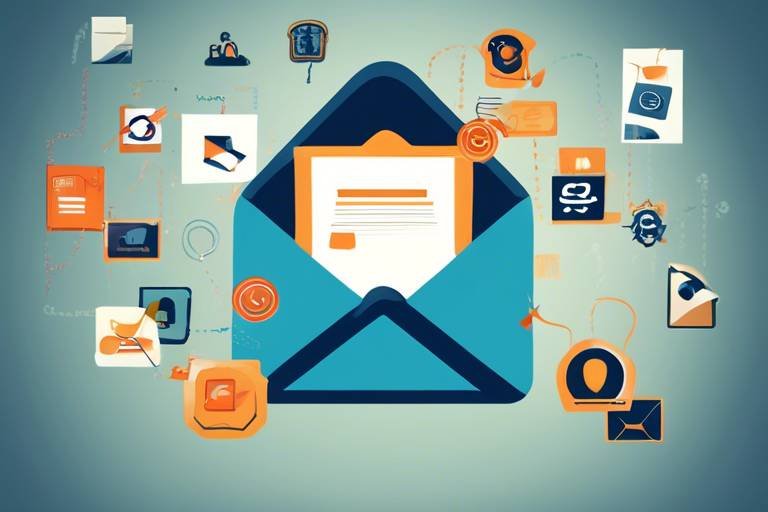Recognizing and Preventing Cyber Fraud
This article explores the various types of cyber fraud, how to identify them, and effective strategies to prevent becoming a victim in today’s digital landscape.
Cyber fraud encompasses a range of deceptive practices aimed at financial gain through illicit means. In a world where technology is integral to our daily lives, understanding its various forms is crucial for effective prevention and protection against potential threats. Imagine walking through a digital marketplace where every corner hides a potential scammer, waiting to exploit your trust. By familiarizing ourselves with the landscape of cyber fraud, we can better equip ourselves to navigate these treacherous waters.
Various types of cyber fraud exist, including phishing, identity theft, and online scams. Familiarizing oneself with these types can help individuals and organizations recognize and mitigate risks more effectively. Just as you wouldn’t walk into a dark alley without a flashlight, understanding these threats can illuminate your path to safety.
Phishing attacks involve fraudulent attempts to obtain sensitive information by masquerading as trustworthy entities. This deceptive tactic is akin to someone wearing a uniform to gain access to restricted areas. Recognizing the signs of phishing is essential for safeguarding personal and financial data. For instance, a sudden email from your bank asking for account verification should raise immediate suspicions.
Email phishing is one of the most prevalent forms, often involving deceptive messages that lure users into revealing personal information. Awareness of common tactics can significantly reduce vulnerability. These emails may contain urgent requests or too-good-to-be-true offers, designed to provoke a quick response. Always remember: if it sounds fishy, it probably is!
SMS phishing, or smishing, utilizes text messages to deceive individuals into providing sensitive information. Understanding this method is vital for effective protection against mobile threats. Just as you wouldn’t give your home address to a stranger at a party, be wary of unsolicited texts asking for personal details. A simple rule: if you didn’t initiate the conversation, don’t share your information.
Identity theft occurs when someone unlawfully obtains and uses another person’s personal information. This can lead to financial ruin and emotional distress. Recognizing the signs of identity theft can help individuals take timely action to protect themselves. For example, unexpected changes in your credit score or unfamiliar transactions on your bank statement can be red flags. It’s essential to stay vigilant, as identity theft can happen to anyone, anywhere.
Being aware of warning signs can help individuals detect potential cyber fraud attempts early. This section outlines key indicators that may suggest fraudulent activity. Think of these signs as the smoke before the fire; they can alert you to danger before it’s too late.
Monitoring for unusual account activity is crucial for early detection of cyber fraud. Recognizing unexpected transactions can prompt timely investigation and action. If you notice a purchase you didn’t make or a login attempt from an unfamiliar location, it’s time to investigate. Just like you’d check your wallet after a night out, keep an eye on your accounts regularly.
Suspicious communications, such as unsolicited emails or messages, should raise red flags. Identifying these communications can prevent falling victim to scams. Remember, legitimate organizations will never ask for sensitive information via email or text. Trust your instincts; if something feels off, it probably is.
Implementing preventive measures is essential for safeguarding against cyber fraud. This section discusses practical steps individuals and organizations can take to enhance their security. Think of these measures as the locks on your doors; they keep unwanted intruders out.
Using strong, unique passwords is a fundamental practice for preventing unauthorized access. Implementing password management strategies can significantly improve overall security. Consider using a mix of letters, numbers, and symbols, and avoid using easily guessable information like birthdays or names. A password manager can help you keep track of these complex passwords without the headache of remembering them all.
Two-factor authentication adds an extra layer of security by requiring a second form of verification. Adopting this practice can greatly reduce the risk of unauthorized account access. It’s like having a double lock on your door; even if someone has your key, they still can’t get in without the second form of identification.
- What should I do if I suspect I'm a victim of cyber fraud?
Immediately change your passwords, notify your bank, and report the incident to the authorities. - How can I protect my personal information online?
Use strong passwords, enable two-factor authentication, and be cautious about sharing personal details. - Are there any tools to help prevent cyber fraud?
Yes, consider using antivirus software, password managers, and security apps that monitor your accounts.

Understanding Cyber Fraud
This article explores the various types of cyber fraud, how to identify them, and effective strategies to prevent becoming a victim in today’s digital landscape.
Cyber fraud encompasses a range of deceptive practices aimed at financial gain through illicit means. In an age where our lives are increasingly digital, understanding the various forms of cyber fraud is crucial for effective prevention and protection against potential threats. Just like a magician distracts you with one hand while the other is busy pulling off a trick, cyber fraudsters use sophisticated methods to deceive unsuspecting victims. They exploit vulnerabilities in technology, human psychology, and trust to achieve their goals.
At its core, cyber fraud is about manipulation. Fraudsters may use social engineering techniques, which involve psychological manipulation to trick individuals into divulging confidential information. It's like a wolf in sheep's clothing; they often present themselves as trustworthy entities, making it difficult to discern their true intentions. This manipulation can take various forms, from phishing emails to fake websites designed to look legitimate.
There are several common types of cyber fraud that you should be aware of, including:
- Phishing: Fraudulent attempts to obtain sensitive information by masquerading as trustworthy entities.
- Identity Theft: The unlawful acquisition and use of someone else's personal information.
- Online Scams: Various deceptive practices conducted over the internet, often promising unrealistic returns or rewards.
Understanding these types of fraud is the first step in protecting yourself. Just as one would learn about the different types of illnesses to maintain good health, familiarizing oneself with the landscape of cyber fraud can empower individuals and organizations to recognize and mitigate risks more effectively. Remember, knowledge is power, especially in the digital world where threats can be lurking around every corner.
In summary, cyber fraud is a multifaceted issue that requires vigilance and awareness. By understanding the tactics employed by fraudsters and the various forms of cyber fraud, you can better equip yourself to avoid falling victim to these malicious schemes. As we delve deeper into the specifics of different types of cyber fraud, you'll gain insights that can help you safeguard your personal and financial information.
Various types of cyber fraud exist, including phishing, identity theft, and online scams. Familiarizing oneself with these types can help individuals and organizations recognize and mitigate risks more effectively.
Phishing attacks involve fraudulent attempts to obtain sensitive information by masquerading as trustworthy entities. Recognizing the signs of phishing is essential for safeguarding personal and financial data.
Email phishing is one of the most prevalent forms, often involving deceptive messages that lure users into revealing personal information. Awareness of common tactics can significantly reduce vulnerability.
SMS phishing, or smishing, utilizes text messages to deceive individuals into providing sensitive information. Understanding this method is vital for effective protection against mobile threats.
Identity theft occurs when someone unlawfully obtains and uses another person’s personal information. Recognizing the signs of identity theft can help individuals take timely action to protect themselves.
Being aware of warning signs can help individuals detect potential cyber fraud attempts early. This section outlines key indicators that may suggest fraudulent activity.
Monitoring for unusual account activity is crucial for early detection of cyber fraud. Recognizing unexpected transactions can prompt timely investigation and action.
Suspicious communications, such as unsolicited emails or messages, should raise red flags. Identifying these communications can prevent falling victim to scams.
Implementing preventive measures is essential for safeguarding against cyber fraud. This section discusses practical steps individuals and organizations can take to enhance their security.
Using strong, unique passwords is a fundamental practice for preventing unauthorized access. Implementing password management strategies can significantly improve overall security.
Two-factor authentication adds an extra layer of security by requiring a second form of verification. Adopting this practice can greatly reduce the risk of unauthorized account access.
Q: What is cyber fraud?
A: Cyber fraud refers to deceptive practices aimed at obtaining sensitive information or money through illicit means, often using the internet.
Q: How can I protect myself from cyber fraud?
A: You can protect yourself by using strong passwords, enabling two-factor authentication, and being cautious with unsolicited communications.
Q: What should I do if I suspect I've been a victim of cyber fraud?
A: If you suspect you've been a victim, immediately change your passwords, monitor your accounts for unusual activity, and report the incident to relevant authorities.

Common Types of Cyber Fraud
In today's digital age, cyber fraud has become an alarming concern, affecting individuals and organizations alike. Understanding the various types of cyber fraud is essential for anyone who navigates the online world. Among the most common forms are phishing, identity theft, and a plethora of online scams. By familiarizing yourself with these tactics, you can better recognize potential threats and protect your sensitive information.
Phishing attacks are perhaps the most notorious form of cyber fraud. These deceptive practices involve tricking individuals into divulging personal information by pretending to be trustworthy entities. Imagine receiving an email that looks like it’s from your bank, asking you to verify your account details. It’s alarming how easily one can fall into this trap. Phishing can occur through various channels, including email and text messages, making it crucial to stay vigilant.
Phishing attacks come in many flavors, each designed to exploit human psychology. The most prevalent type is email phishing, where cybercriminals send out fraudulent emails that mimic legitimate organizations. These emails often contain links that lead to fake websites designed to capture your login credentials. Recognizing the signs of such emails—like poor grammar, urgent calls to action, and unfamiliar sender addresses—can significantly reduce your vulnerability.
Email phishing remains a top threat. It often involves messages that appear to be from well-known companies, urging you to click on a link or download an attachment. For example, you might receive an email claiming that your account will be suspended unless you verify your information immediately. This creates a sense of urgency, pushing you to act without thinking. Always double-check the sender's email address and look for signs of tampering before engaging with such messages.
Another rising threat is SMS phishing, commonly referred to as smishing. This method uses text messages to deceive individuals into providing sensitive information. Imagine receiving a text that claims you’ve won a prize, but first, you need to verify your identity by clicking a link. Just like email phishing, smishing exploits trust and urgency. Be cautious about any unsolicited messages, especially those requesting personal details.
Identity theft is another significant concern in the realm of cyber fraud. This occurs when someone unlawfully acquires and uses another person's personal information—such as Social Security numbers, bank account details, or credit card information—often for financial gain. The impact of identity theft can be devastating, leading to financial ruin and long-lasting credit damage. Recognizing the signs of identity theft, such as unexplained charges or unfamiliar accounts in your name, is crucial for timely intervention.
Ultimately, being aware of these common types of cyber fraud is the first step toward protecting yourself. Knowledge is power, and understanding how these scams operate can help you stay one step ahead of cybercriminals. As we dive deeper into this topic, remember that vigilance and awareness are your best defenses.
What is cyber fraud?
Cyber fraud refers to various deceptive practices that aim to obtain personal or financial information through illicit means. It includes tactics like phishing, identity theft, and online scams.
How can I recognize phishing emails?
Look for signs such as poor grammar, unfamiliar sender addresses, and urgent requests for personal information. Always verify the sender before clicking any links.
What should I do if I suspect identity theft?
If you suspect identity theft, immediately check your accounts for unauthorized transactions, report it to your bank, and consider placing a fraud alert on your credit report.
Is SMS phishing common?
Yes, SMS phishing, or smishing, is increasingly common as more people rely on their mobile devices for communication. Always be cautious of unsolicited texts asking for personal information.

Phishing Attacks
Phishing attacks are one of the most insidious forms of cyber fraud, and they often come disguised as friendly communications from trusted sources. Imagine checking your email and seeing a message that looks like it’s from your bank, urging you to verify your account details. It’s alarming how easily someone can impersonate a legitimate entity to trick you into revealing sensitive information. The reality is, these deceptive tactics can happen to anyone, and they have become increasingly sophisticated over the years.
When it comes to phishing, there are several common tactics that fraudsters employ. They might send you an email that appears to be from a reputable company, complete with official logos and language that seems genuine. However, a closer inspection could reveal subtle inconsistencies, such as a misspelled domain name or a generic greeting instead of your name. This is why being vigilant is crucial. You should always ask yourself: does this message feel right? If something seems off, it probably is.
Phishing is not limited to just emails; it can also occur through text messages, a method known as SMS phishing or smishing. In these cases, you might receive a text that appears to come from your service provider, asking you to click on a link to update your account information. This link could lead to a fake website designed to steal your credentials. The bottom line is, whether it’s an email or a text, always approach unsolicited communications with caution.
So, how can you protect yourself from falling into the phishing trap? Here are some effective strategies:
- Verify the Source: Always check the sender's email address or phone number. If it looks suspicious, don’t engage.
- Look for Red Flags: Be wary of urgent requests for personal information or messages that create a sense of panic.
- Hover Over Links: Before clicking, hover over any links to see the actual URL. If it doesn’t match the supposed sender, don’t click.
In addition to these measures, consider using security software that includes phishing protection. Many antivirus programs now offer features that can block known phishing sites and warn you of potential threats. Remember, the best defense against phishing attacks is a proactive approach. Stay informed, stay alert, and always think twice before sharing your personal information.
Q: What should I do if I suspect I've been phished?
A: If you believe you've fallen victim to a phishing scam, immediately change your passwords and contact your bank or service provider. Monitor your accounts for any unauthorized transactions.
Q: Can phishing attacks happen on social media?
A: Absolutely! Phishing can occur on social media platforms as well. Be cautious of unsolicited messages and friend requests, especially if they ask for personal information.
Q: Is it safe to click on links in emails from known contacts?
A: Even if the email appears to be from someone you know, it’s best to verify with them directly. Their account may have been compromised, and the message could be a phishing attempt.

Email Phishing
Email phishing is one of the most insidious forms of cyber fraud, where attackers craft deceptive messages that appear to come from legitimate sources, such as banks, online services, or even friends. These emails often contain urgent calls to action, enticing recipients to click on malicious links or download harmful attachments. Think of it as a wolf in sheep's clothing; the email looks harmless, but its true intent is to steal your sensitive information or install malware on your device.
Recognizing the common tactics used in email phishing is essential for safeguarding your personal and financial data. For instance, phishing emails often contain grammatical errors or unusual phrasing that can be a giveaway. Additionally, they may use generic greetings like "Dear Customer" instead of your actual name. Be wary of emails that create a sense of urgency, prompting you to act quickly without thinking. Here are some typical characteristics of phishing emails:
- Suspicious Sender: Always verify the sender's email address. Phishing emails may come from addresses that look similar but have slight variations.
- Urgent Requests: Phrases like "Your account will be suspended!" or "Immediate action required!" are red flags.
- Links and Attachments: Hover over links to see their actual destination before clicking, and avoid downloading attachments from unknown sources.
Moreover, attackers may use social engineering techniques to make their emails more convincing. They might reference recent events, your online behavior, or even information gathered from social media to create a false sense of trust. This is why it's crucial to maintain a healthy skepticism when checking your inbox. If something seems off, trust your instincts and investigate further before taking any action.
To protect yourself from email phishing, consider implementing the following best practices:
- Use Spam Filters: Most email services offer spam filters that can help catch phishing attempts before they reach your inbox.
- Educate Yourself: Stay informed about the latest phishing scams and tactics to recognize them more easily.
- Report Suspicious Emails: If you receive a phishing email, report it to your email provider to help protect others.
In conclusion, email phishing is a prevalent threat that requires vigilance and awareness. By being proactive and skeptical, you can significantly reduce your risk of falling victim to these deceitful schemes. Remember, the best defense against phishing is a well-informed user who knows how to spot the signs and act accordingly.
Q: What should I do if I think I've fallen for a phishing scam?
A: If you suspect you've been a victim of phishing, immediately change your passwords for affected accounts, enable two-factor authentication, and monitor your financial accounts for any unauthorized transactions.
Q: Can I recover my stolen identity after a phishing attack?
A: Recovery is possible, but it can be a lengthy process. Report the identity theft to relevant authorities, and consider placing a fraud alert on your credit report.
Q: How can I educate others about phishing?
A: Share information on social media, host discussions, or create informative materials to help raise awareness about phishing and its dangers.

SMS Phishing
SMS phishing, often referred to as smishing, is a cunning tactic employed by cybercriminals to trick individuals into divulging sensitive information via text messages. Unlike traditional phishing, which typically occurs through emails, smishing takes advantage of the immediacy and personal nature of text messaging. Imagine receiving a text from your bank, claiming there’s been suspicious activity on your account, urging you to click a link to verify your details. Sounds legitimate, right? But herein lies the danger!
These deceptive messages can come from seemingly trustworthy sources, such as banks, government agencies, or popular online services. The goal is to create a sense of urgency, prompting you to act quickly without thinking twice. To better understand how smishing operates, let's break down its common characteristics:
- Urgency: Messages often convey a sense of immediate action required, making you feel pressured.
- Links: They frequently include links that lead to fake websites designed to steal your information.
- Impersonation: Cybercriminals may impersonate legitimate companies, using logos and language that appear authentic.
Recognizing these signs is vital for your protection. If you ever receive a suspicious text, resist the urge to click any links or respond with personal information. Instead, it’s best to contact the organization directly through official channels to verify the legitimacy of the message. Remember, your personal information is like a treasure; guard it fiercely!
Moreover, being proactive is essential. Here are some practical tips to help you avoid falling victim to smishing:
- Do not click links: If you receive a text from an unknown number, avoid clicking any links provided.
- Verify the sender: Always confirm the identity of the sender by contacting the company directly.
- Report suspicious messages: Forward any suspicious texts to your mobile carrier or report them to relevant authorities.
In today's fast-paced digital world, staying informed about the tactics used by cybercriminals is your best defense against SMS phishing. By maintaining a skeptical mindset and being vigilant, you can significantly reduce the risk of becoming a victim of these deceptive schemes.
What is SMS phishing?
SMS phishing, or smishing, is a type of cyber fraud where attackers send deceptive text messages to trick individuals into providing sensitive information.
How can I identify a smishing attempt?
Look for messages that create a sense of urgency, contain suspicious links, or impersonate legitimate organizations. Always verify the sender before taking any action.
What should I do if I receive a suspicious text?
Do not click any links or respond. Instead, contact the organization directly using official channels to confirm the message's authenticity.
Can I report smishing attempts?
Yes, you can report suspicious messages to your mobile carrier and relevant authorities to help prevent others from falling victim.

Identity Theft
Identity theft is a serious crime that occurs when someone unlawfully obtains and uses another person's personal information, often for financial gain. Imagine waking up one day to find that your bank account has been drained, your credit cards maxed out, and loans taken out in your name—all without your knowledge. It’s a nightmare that can leave you feeling violated and vulnerable. The methods used by identity thieves can vary widely, but the impact is always devastating. They can use your personal data to open accounts, make purchases, or even commit crimes, leaving you to deal with the fallout.
Recognizing the signs of identity theft early can be a game-changer. Here are some key indicators that you might be a victim:
- Unfamiliar Transactions: If you notice charges on your bank statement or credit report that you didn’t authorize, it could be a sign that someone is using your identity.
- Unexpected Bills: Receiving bills for services you didn’t sign up for can indicate that someone has opened accounts in your name.
- Credit Report Changes: Regularly checking your credit report can help you spot any suspicious activity, such as new accounts that you didn’t create.
So, how can you protect yourself from becoming a victim of identity theft? The best defense is a proactive approach. Start by safeguarding your personal information. This means being cautious about sharing your Social Security number, bank details, and other sensitive data, especially online. Additionally, consider using services that monitor your personal information and alert you to any unusual activity. If you suspect that your information has been compromised, acting quickly is crucial. Contact your bank, credit card companies, and local authorities to report the theft and mitigate damage.
Ultimately, awareness and vigilance are your best allies in the fight against identity theft. By staying informed and taking preventive measures, you can significantly reduce your risk and protect your financial future.
1. What should I do if I suspect I am a victim of identity theft?
If you suspect identity theft, immediately contact your bank and credit card companies to freeze your accounts. Report the theft to the Federal Trade Commission (FTC) and file a police report. This documentation will be important as you work to resolve the situation.
2. How can I protect my personal information online?
To protect your personal information online, use strong, unique passwords for each account, enable two-factor authentication, and be cautious about sharing personal details on social media. Regularly monitor your financial statements for any unauthorized transactions.
3. Can I recover my identity after it has been stolen?
Yes, it is possible to recover from identity theft, but it can be a lengthy process. You will need to work closely with financial institutions, credit bureaus, and law enforcement to restore your identity and rectify any fraudulent activities.

Recognizing Warning Signs
In a world where technology is woven into the fabric of our daily lives, being vigilant about potential cyber fraud is more crucial than ever. Just like a hawk eyes its prey, you too must scan your digital environment for any signs of trouble. Cyber fraudsters are cunning, often hiding in plain sight, so recognizing the warning signs can be your first line of defense. You might ask, "What should I be looking for?" Well, let's dive into some key indicators that can help you spot potential threats before they escalate.
One of the most alarming signs of cyber fraud is unusual account activity. This could manifest as unexpected transactions, changes to your account settings, or even new devices accessing your accounts. Imagine waking up to find that your bank account has been drained overnight. It’s a nightmare scenario, but monitoring your accounts regularly can help you catch these anomalies early. If you notice anything out of the ordinary, don’t hesitate to investigate further or contact your financial institution.
Another red flag is suspicious communications. This includes unsolicited emails, texts, or phone calls that request personal information or prompt you to click on dubious links. Think of these communications as wolves in sheep’s clothing. They may appear legitimate at first glance, but a closer inspection often reveals their true nature. If you receive a message that seems off, trust your instincts and verify the source before responding.
Additionally, be wary of pressure tactics. Cybercriminals often use urgency to manipulate their victims into making hasty decisions. For example, they might claim that your account will be locked unless you provide your personal information immediately. This is a classic tactic designed to create panic and lead you to act without thinking. Always take a step back and assess the situation calmly. If it feels rushed, it’s likely a scam.
To further illustrate these warning signs, consider the following table that summarizes key indicators of cyber fraud:
| Warning Sign | Description |
|---|---|
| Unusual Account Activity | Unexpected transactions or changes in account settings. |
| Suspicious Communications | Unsolicited messages asking for personal information. |
| Pressure Tactics | Manipulative messages creating a sense of urgency. |
By keeping an eye out for these warning signs, you can significantly reduce your risk of becoming a victim of cyber fraud. Remember, awareness is your best ally in this digital landscape. Just as you wouldn’t ignore a strange noise in your home, don’t overlook suspicious activities online. Trust your instincts, stay informed, and take action when necessary.
- What should I do if I suspect I am a victim of cyber fraud? If you suspect fraud, immediately contact your bank or service provider, change your passwords, and monitor your accounts for further suspicious activity.
- How can I report cyber fraud? You can report cyber fraud to your local authorities, as well as to organizations like the Federal Trade Commission (FTC) in the U.S.
- Are there tools to help detect cyber fraud? Yes, various tools such as antivirus software, firewalls, and identity theft protection services can help detect and prevent cyber fraud.

Unusual Account Activity
Keeping an eye on your financial accounts is not just a good practice; it’s essential in the fight against cyber fraud. can be a telltale sign that something is amiss. Imagine waking up one morning to find several unauthorized transactions in your bank statement. It’s a nightmare scenario that can happen to anyone if they aren’t vigilant. So, what exactly should you look out for?
First off, any unexpected transactions—whether they are charges you don’t recognize or sudden withdrawals—should immediately raise a red flag. Even small amounts can indicate that someone has gained access to your account. For instance, if you notice a charge of $5.99 from a subscription service you never signed up for, it could be a sign of a larger issue. Cybercriminals often test stolen credit card information with small purchases before making larger ones.
Additionally, be wary of login attempts from unfamiliar devices or locations. Most banking apps will notify you if there’s been a login from an unrecognized device. If you receive such a notification and you haven’t logged in, it’s crucial to take immediate action. Change your password and enable security features like two-factor authentication to safeguard your account.
Another sign to watch for is changes in account settings. If you find that your email address, phone number, or other personal details have been altered without your consent, it’s a clear indication of unauthorized access. Cybercriminals often change these settings to lock you out of your own account, making it easier for them to commit fraud.
To help you better understand the types of unusual account activities, here’s a quick table summarizing key indicators:
| Indicator | Description |
|---|---|
| Unexpected Transactions | Charges or withdrawals that you do not recognize. |
| Login Alerts | Notifications about logins from unfamiliar devices or locations. |
| Account Setting Changes | Alterations to your personal information without your knowledge. |
| Unusual Account Activity | Frequent or large transactions that deviate from your normal spending habits. |
In summary, being proactive about monitoring your accounts can save you from falling victim to cyber fraud. If you notice any unusual account activity, don’t hesitate to take action. Report it to your financial institution and consider placing a fraud alert on your credit report. Remember, in the world of cyber fraud, it’s always better to be safe than sorry!
What should I do if I notice unusual activity in my account?
If you notice any unusual activity, contact your bank or financial institution immediately. Change your passwords and enable additional security measures like two-factor authentication.
How can I monitor my accounts for unusual activity?
Regularly check your bank statements and transaction history. Many banks also offer alerts for transactions, which can help you stay informed.
What are the signs of identity theft?
Signs of identity theft include unfamiliar charges, changes to your account settings, and receiving bills for items you didn’t purchase. Always be vigilant and report any suspicious activity.

Suspicious Communications
In today's fast-paced digital world, can pop up when you least expect them, often disguised as legitimate messages from trusted sources. These communications can take many forms, including emails, text messages, or even phone calls. The key is to stay vigilant and recognize the red flags that signal potential fraud. For instance, if you receive an email from your bank asking you to verify your account information, it’s crucial to pause and think: is this really from my bank?
One common tactic used by fraudsters is to create a sense of urgency. They might say something like, "Your account will be suspended unless you act immediately!" This is designed to pressure you into making hasty decisions without properly analyzing the situation. Always remember, legitimate organizations will never ask for sensitive information through insecure channels. If you encounter such messages, it's wise to contact the organization directly using official contact details rather than responding to the suspicious communication.
Here are some specific signs to look out for when evaluating the authenticity of a communication:
- Generic Greetings: Be wary of messages that start with "Dear Customer" instead of using your name.
- Spelling and Grammar Mistakes: Many fraudulent communications are poorly written, with numerous typos or awkward phrasing.
- Unusual Requests: If someone asks for personal information, passwords, or payment details unexpectedly, it’s a major red flag.
- Unfamiliar Sender: Always double-check the email address or phone number. Fraudsters often use addresses that look similar to legitimate ones.
Furthermore, it’s essential to consider the context of the communication. If you receive a message regarding an account you don’t have or a service you didn’t sign up for, it’s likely a scam. Trust your instincts; if something feels off, it probably is. Another effective strategy is to use a search engine to look up the organization mentioned in the communication. You might find reports from others who have encountered similar scams.
In summary, staying informed and cautious is your best defense against suspicious communications. By recognizing the signs and knowing how to respond, you can significantly reduce the risk of falling victim to cyber fraud. Remember, when in doubt, it’s always better to verify than to regret!
Q: How can I verify if a communication is legitimate?
A: Always check the sender's email address, look for signs of urgency, and contact the organization directly using official contact information.
Q: What should I do if I suspect a communication is fraudulent?
A: Do not respond or click on any links. Report the communication to the relevant organization and consider informing your local authorities.
Q: Are there any tools to help identify phishing attempts?
A: Yes! Many email clients have built-in filters for phishing. Additionally, you can use browser extensions that alert you to suspicious sites.

Preventive Measures
In today’s digital age, where cyber fraud is rampant, taking proactive steps to safeguard your personal and financial information is more important than ever. Implementing effective preventive measures can significantly reduce your risk of becoming a victim. One of the most fundamental practices is using strong and unique passwords for all your online accounts. A strong password typically includes a mix of uppercase and lowercase letters, numbers, and special characters. For instance, instead of using "Password123", consider a more complex alternative like "C0mpl3x#P@ssw0rd!" This simple change can make a world of difference in your online security.
Moreover, maintaining a password management strategy is essential. Many people struggle to remember complex passwords for multiple accounts, which can lead to the temptation of reusing passwords. A password manager can help you generate and store unique passwords securely, ensuring that you never have to compromise on security. Additionally, regularly updating your passwords—at least every three to six months—can further enhance your protection against potential breaches.
Another highly effective preventive measure is the implementation of two-factor authentication (2FA). This security feature adds an extra layer of protection by requiring not only your password but also a second form of verification, such as a code sent to your mobile device. By enabling 2FA, even if a hacker manages to steal your password, they would still need access to your second form of verification to gain entry into your account. This significantly reduces the likelihood of unauthorized access.
Furthermore, being vigilant about the links you click and the attachments you open is crucial. Cyber fraudsters often use deceptive emails and messages to lure unsuspecting victims into revealing sensitive information. Always double-check the sender's email address and look for signs of phishing attempts, such as poor grammar or urgent calls to action. If something seems off, it’s better to err on the side of caution and not engage with the content.
Lastly, keep your devices and software updated. Regular updates often include security patches that protect against newly discovered vulnerabilities. Enable automatic updates whenever possible to ensure that you’re always equipped with the latest security measures. By combining these strategies—strong passwords, two-factor authentication, cautious online behavior, and regular updates—you create a robust defense against cyber fraud.
- What is cyber fraud? Cyber fraud refers to deceptive practices conducted online with the intent of financial gain, encompassing various scams such as phishing and identity theft.
- How can I recognize phishing attempts? Look out for suspicious emails or messages that create a sense of urgency, contain poor grammar, or come from unknown senders.
- Is two-factor authentication really necessary? Yes, it adds an essential layer of security that significantly reduces the risk of unauthorized access to your accounts.
- What should I do if I suspect identity theft? Immediately report the incident to your bank, credit card company, and local authorities. Monitor your accounts for any unusual activity.

Strong Password Practices
In today's digital age, where our lives are intertwined with technology, the importance of cannot be overstated. Think of your password as the lock on your front door; if it's weak or easily picked, you’re inviting trouble right into your home. So, how do we create a robust password that stands up against cyber fraud? The first step is to ensure that your password is not only long but also complex. A good rule of thumb is to aim for at least 12 characters, incorporating a mix of uppercase letters, lowercase letters, numbers, and special symbols. For example, instead of using a simple password like "password123," consider something more intricate like "P@55w0rd!2023".
Moreover, it’s vital to avoid using easily guessable information, such as your name, birth date, or common words. Cybercriminals often utilize brute force attacks, where they systematically try a multitude of combinations until they find the right one. By making your password unique and unpredictable, you significantly reduce the chances of falling victim to such attacks. To help you understand the difference between weak and strong passwords, consider the following table:
| Weak Passwords | Strong Passwords |
|---|---|
| 123456 | G7!xq@3B$wz |
| password | |
| qwerty | n0t4c0mpl3xP@ss |
Another effective strategy is to use a password manager. These tools can generate and store complex passwords for you, so you don't have to remember each one. It’s like having a personal vault for all your sensitive information, making it easier to use unique passwords for every account without the mental burden. Just remember to keep your master password for the password manager extremely secure!
Additionally, consider changing your passwords regularly. This may seem tedious, but it’s a crucial step in maintaining your security. Set a reminder to update your passwords every few months, especially for accounts that contain sensitive information. And while you're at it, don't reuse passwords across multiple accounts. If one account gets compromised, it could lead to a domino effect, putting all your other accounts at risk.
Lastly, it’s essential to enable two-factor authentication (2FA) wherever possible. This adds an extra layer of security by requiring a second form of verification, like a text message or an authentication app, in addition to your password. It’s like having a second lock on your door; even if someone manages to pick the first one, they still can’t get in without the second key.
By adopting these strong password practices, you are not just protecting your online accounts; you are fortifying your digital life against the ever-evolving threats of cyber fraud. Remember, in the world of cybersecurity, vigilance and proactive measures are your best defense!
- What makes a password strong? A strong password is typically at least 12 characters long, includes a mix of letters, numbers, and symbols, and avoids easily guessable information.
- How often should I change my passwords? It’s advisable to change your passwords every 3 to 6 months, especially for sensitive accounts.
- Is using a password manager safe? Yes, password managers are designed to securely store and encrypt your passwords, making them a safer option than trying to remember them all.
- What is two-factor authentication? Two-factor authentication is an extra layer of security that requires not only your password but also a second form of verification, such as a code sent to your phone.

Two-Factor Authentication
Two-factor authentication (2FA) is like having a bouncer at the door of your digital life, ensuring that only the right people get in. Imagine you’re trying to enter a club, and not only do you need to show your ID (your password), but you also have to provide a secret code sent to your phone. This extra step dramatically increases your security and makes it much harder for cybercriminals to gain access to your accounts, even if they somehow manage to steal your password.
In today’s world, where cyber threats are lurking around every digital corner, relying solely on passwords is no longer sufficient. Passwords can be weak, reused across multiple sites, or easily guessed. By implementing 2FA, you add an additional layer of defense that requires not only something you know but also something you have. This dual requirement means that even if a hacker gets hold of your password, they still can’t access your account without that second piece of information.
There are several methods of two-factor authentication that you can choose from, and understanding these options can help you decide which is best for your needs. Here’s a quick rundown:
- SMS Verification: A code is sent to your mobile device via text message. While convenient, be cautious as SMS can be intercepted.
- Authentication Apps: Apps like Google Authenticator or Authy generate time-sensitive codes that you can use. These are generally more secure than SMS.
- Email Verification: Some services send a code to your email, but keep in mind that if your email is compromised, this method loses its effectiveness.
- Hardware Tokens: Devices like YubiKey provide a physical form of verification that plugs into your computer or connects via NFC.
Implementing two-factor authentication is a straightforward process. Most online services that store sensitive information offer 2FA as an option in their security settings. By enabling it, you can significantly reduce the risk of unauthorized access. It’s like locking your front door and then installing a security system; it’s all about making it harder for intruders.
However, while 2FA is a powerful tool, it’s not foolproof. Users must remain vigilant and aware of potential phishing attempts that could trick them into revealing their authentication codes. Always remember, no security measure is entirely effective if you don’t practice good cyber hygiene.
In conclusion, two-factor authentication is an essential step in protecting your digital identity. By adding this layer of security, you can sleep a little easier knowing that your accounts are significantly more secure against the threats of cyber fraud. So, take action today—enable two-factor authentication on all your important accounts, and make it a habit to check for any suspicious activity regularly.
Q: What is two-factor authentication?
A: Two-factor authentication (2FA) is a security process that requires two different forms of identification before granting access to an account.
Q: Why should I use two-factor authentication?
A: Using 2FA significantly enhances your security by requiring both something you know (your password) and something you have (a code sent to your phone or generated by an app).
Q: Is two-factor authentication completely foolproof?
A: While 2FA greatly increases security, it is not entirely foolproof. Users must still be cautious of phishing attempts and practice good cyber hygiene.
Q: How do I enable two-factor authentication?
A: Most online services provide an option to enable 2FA in their security settings. Look for options related to account security or two-factor authentication.
Q: What if I lose access to my second factor?
A: Many services offer backup codes or alternative recovery methods. It's crucial to keep these in a safe place.
Frequently Asked Questions
- What is cyber fraud?
Cyber fraud refers to a range of deceptive practices aimed at financial gain through illicit means, often leveraging technology and the internet. It includes various tactics like phishing, identity theft, and online scams that target individuals and organizations alike.
- How can I recognize phishing attacks?
Phishing attacks can often be recognized by suspicious emails or messages that ask for personal information. Look for signs like poor spelling and grammar, urgent requests for personal data, or links that don’t match the sender's legitimate website. Always verify the source before clicking on any links.
- What should I do if I suspect identity theft?
If you suspect identity theft, act quickly! Monitor your accounts for unusual activity, change your passwords immediately, and report the theft to your bank and credit bureaus. It’s also wise to consider placing a fraud alert on your credit report to prevent further misuse of your information.
- What are the warning signs of cyber fraud?
Warning signs of cyber fraud can include unusual account activity, such as unauthorized transactions, and suspicious communications like unsolicited emails or texts. If something feels off, trust your instincts and investigate further.
- How can I protect myself from cyber fraud?
To protect yourself from cyber fraud, implement strong password practices, use two-factor authentication, and stay informed about the latest scams. Regularly updating your software and being cautious with the information you share online can also enhance your security.
- What is the importance of strong passwords?
Strong passwords are crucial because they serve as the first line of defense against unauthorized access to your accounts. A strong password typically includes a mix of letters, numbers, and special characters, making it harder for cybercriminals to guess or crack.
- What is two-factor authentication and why should I use it?
Two-factor authentication (2FA) is a security measure that requires two forms of verification before granting access to your accounts. This additional layer of security significantly reduces the risk of unauthorized access, making it much harder for cybercriminals to compromise your information.



















